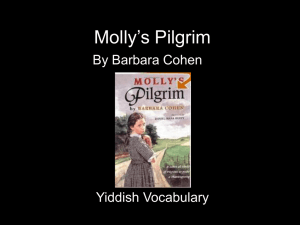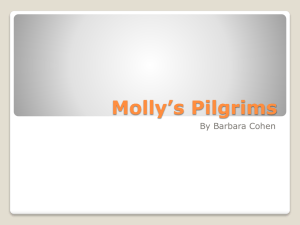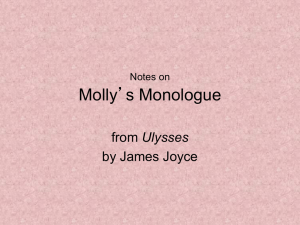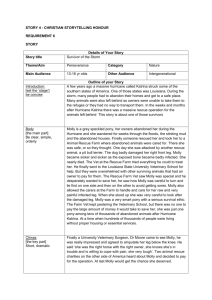RABBIT PROOF FENCE – ANALYSING TECHNIQUES
advertisement
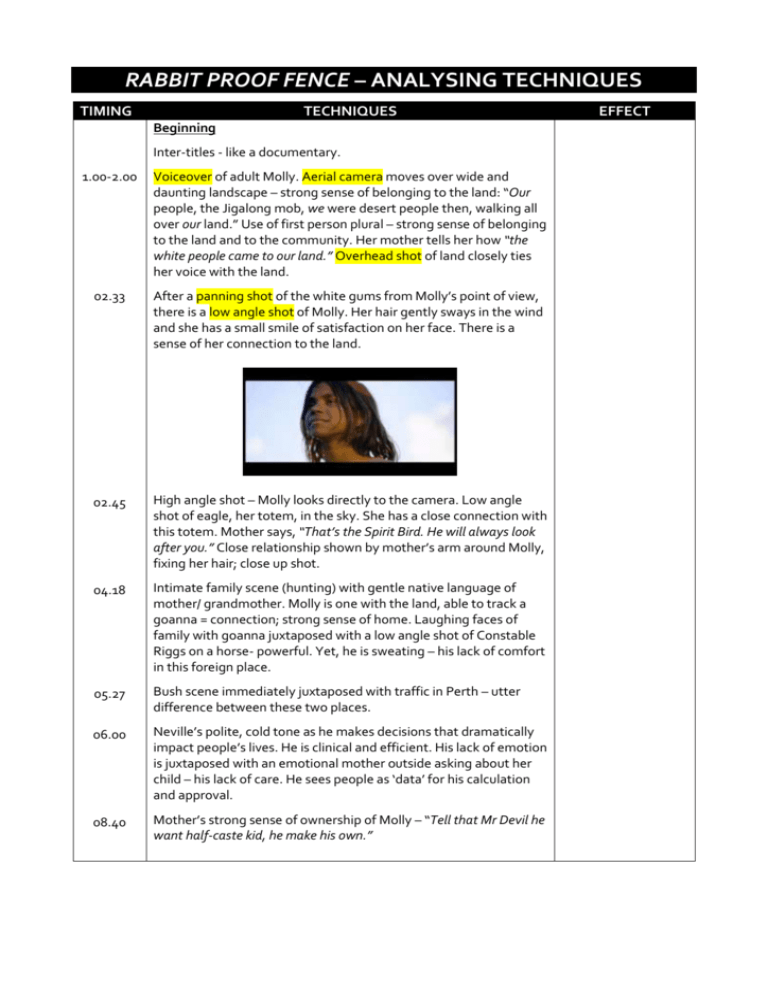
RABBIT PROOF FENCE – ANALYSING TECHNIQUES TIMING TECHNIQUES Beginning Inter-titles - like a documentary. 1.00-2.00 Voiceover of adult Molly. Aerial camera moves over wide and daunting landscape – strong sense of belonging to the land: “Our people, the Jigalong mob, we were desert people then, walking all over our land.” Use of first person plural – strong sense of belonging to the land and to the community. Her mother tells her how “the white people came to our land.” Overhead shot of land closely ties her voice with the land. 02.33 After a panning shot of the white gums from Molly’s point of view, there is a low angle shot of Molly. Her hair gently sways in the wind and she has a small smile of satisfaction on her face. There is a sense of her connection to the land. 02.45 High angle shot – Molly looks directly to the camera. Low angle shot of eagle, her totem, in the sky. She has a close connection with this totem. Mother says, “That’s the Spirit Bird. He will always look after you.” Close relationship shown by mother’s arm around Molly, fixing her hair; close up shot. 04.18 Intimate family scene (hunting) with gentle native language of mother/ grandmother. Molly is one with the land, able to track a goanna = connection; strong sense of home. Laughing faces of family with goanna juxtaposed with a low angle shot of Constable Riggs on a horse- powerful. Yet, he is sweating – his lack of comfort in this foreign place. 05.27 Bush scene immediately juxtaposed with traffic in Perth – utter difference between these two places. 06.00 Neville’s polite, cold tone as he makes decisions that dramatically impact people’s lives. He is clinical and efficient. His lack of emotion is juxtaposed with an emotional mother outside asking about her child – his lack of care. He sees people as ‘data’ for his calculation and approval. 08.40 Mother’s strong sense of ownership of Molly – “Tell that Mr Devil he want half-caste kid, he make his own.” EFFECT TIMING TECHNIQUES Capture 08.43 Calm before storm of capture – Daisy and Gracie play on the ground with a tin circle – sense of their normal quiet life. Sense of foreboding – something bad will happen. 08.50 A nearby camel gives a grunt-like roar. Change from close up on Molly’s curious face to long shot of the camel. A car quickly comes into the shot. 08.58 Mid shot of the car crashing over a broken tree branch – symbolic of the destruction to the family unit that he will cause. 09.06 As the policeman quickly gets out of the car, the camel continues to roar. The tempo is building – noise builds. Film almost becomes slow motion as the women realise the purpose of the visit. There is a midshot of the women shouting, “Run”, and there is a fast rhythmic drumbeat. 09.20 There is a tracking shot beside the girls as they run, juxtaposed with another camera in the car with Riggs. Both perspectives are given. As Riggs tries to grab the girls, there is a point of view shot (his perspective) – higher angle than the family – sense of power over them. Screaming, drumbeat creates a sense of emotional drama as their belonging to their family is threatened. A brief moment of calm occurs as the younger girls get in the car. A softer score gains volume as the shots, screams and cries mix with the musical score. The jerky movements of the camera as Molly resists Riggs trying to get her into the car create a sense that the responder is part of the scene. We feel the powerlessness of the women as they ineffectually slap the car’s strong metal and windows. The window acts as a barrier between Molly and her mother, symbolising their new separation/alienation from each other. The girls look small and vulnerable in the big back seat. 11.00 11.24 11.34 Tracking shot of the women chasing the car with dramatic drumbeat music, then a long shot of them falling to the ground as the music fades and their wails are all that can be heard. This changes to a low angle shot of the women defeated on the ground, with only the receding vision of the car leaving in the distance and the car’s dust. Eerie quiet underscored by the utter stillness of the camera. Background wailing, sound of rock as grandmother hits her head with it - utter powerlessness and suffering. As the women wail, we hear a voiceover of Neville’s speech to the wealthy white women: “as you know, every Aborigine born in this state comes under my control.” Awful juxtaposition of his calm, matter-of-fact manner with the horror of what that control means for these people. There is juxtaposition of their rough clothing and outback setting with Neville’s neat suit, interior lighting of his offices and his British accent. EFFECT TIMING TECHNIQUES Moore River Training Settlement 11.53 Slide show. Neville stands in the spotlight of the slide projector. His shadow on the screen behind him adds an ominous tone, particularly when juxtaposed with the women’s wailing. Language choice: “advanced to white status.” 12.24 Use of pointer with three generations - circling faces - sense of their objectification, lack of individual identity. “Third cross” = de-humanising – like a dog. “The continuing infiltration of white blood finally stamps out the black colour.” Long shot, Neville looks directly at women and speaks slowly, with pauses: “the Aboriginal has simply been... bred... out.” 13.00 13.15 14.00 The “Moore River Training Settlement” – black and white slide seen by viewer before we see the real location. He describes how children have been “gathered up to be given the benefit of everything our culture has to offer” (euphemism, negative experience expressed in positive way). Neville walks around the projector, closer to the women, lowers his voice. Mid shot: “For if we are to fit and train such children for the future, they cannot be left as they are. And in spite of himself, the native must be helped.” He has a small smile on his face – sense that he is caring, but also perhaps malevolent. This is then juxtaposed with a close up on Molly’s tired face, seen through from the other side of bars. There is loud screeching of the train noise. Low angle shot of the high windows, with the trees going past (Molly’s perspective). Low angle shot of the train conductor from the girls’ perspective, who turns to look at them expressionless. The shot changes to a long shot of the girls in a cage within the train carriage – sense that they are animals, not humans – do not belong to ‘white’ ways. When the guard looks down, Molly is the only one who meets his gaze – sense of her strength of character. Long shot of the train dissolves to a mid shot of the campfire and the sound of mourning. The camera pans to show the women huddled around the fire, mourning. Juxtaposed with landscape scene from train – landscape changes to be greener grass. They travel through open scrub, a river gorge and over a bridge at dawn. Sense that this is a new place where the girls do not belong – unfamiliarity. The train’s stream and its clattering, harsh noises add to the feeling of dislocation and negative change. Close up of Gracie’s expressionless face on the back of truck – 14.36 trauma, with two other girls in background sleeping. Changes to a long static camera shot with the truck moving further and further away from the camera along a dirt road – sense of movement from their home. EFFECT This is also reminiscent of the kidnap scene – unwilling capture, like cattle off to the slaughter yards. Jerky movements, discordant sounds, lack of human contact or dialogue heighten the sense of their trauma. These scenes sharply contrast to the quiet, nature-based and nontechnological environment where they grew up. The noisy train journey contrasts to the quiet, contemplative scene where Molly and her mother watch the eagle soar in a soundless sky. TIMING TECHNIQUES 15.00 Arrival at Moore River Native Settlement – at dusk, long shot with white church in background, white matron moving from extreme long shot to the truck. Eerie music plays. Girls viewed from the matron’s perspective – through the gaps in the truck – sense that the girls are being viewed by the white eye. The perspective shifts to seeing her white habit from their perspective in the truck – through the gaps, then back to the matron’s perspective. The camera follows the matron’s movement as she walks around the truck to the back. The eerie music builds in intensity as the girls huddle together in fear. The intended kindness matron’s words, “You poor dears. Such a long way. You must be exhausted,” is undermined by the darkness and the ominous music. 15.31 The perspective changes from matron to the girls’, as the matron leads them to the dormitory. Her tone of voice shifts, “Come along, please… that’s the way,” and her facial expression becomes more impatient. The music builds in intensity, reflecting the girls’ fear. The sudden noise of the truck shocks the girls and the responder, reflecting their nervousness and uncertainty about this new place. 16.20 The camera reflects Molly’s gaze as she looks around the dormitory in disorientation. The dormitory is a dismal and fearful shed where they do not feel that they belong. They are not able to even establish a sense of belonging with the other children – a girl’s whispered question: “Are you from Broome?” is met with the Matron’s curt, “Back to sleep the rest of you. No talking.” 16.40 Shock to see an Aboriginal man banging the side of the shack to wake them up. Clanging bell sound, shouting. The girls huddle together in one bed- their sense of belonging to each other, in contrast to the other girls sleeping in separate beds. “Tracker girl” is given the job of emptying the bucket - neither belongs in white world (as a black girl) nor with the other girls – father works with white people. 18.00 First meal – in an alien building, at alien tables. Girls do not realise that they must stand during prayers - Molly realises first. The irony of the prayers is that after the trauma of this place, they must “Thank you, Lord, for everything.” Matron: “There will be no talking.” 18.40 Mid shot of the girls in a row attempting to eat the food. Molly’s facial expression shows her disgust. There is a close up as Daisy speaks an Aboriginal word as she eats the food. The responder hears a loud noise and sees the end of the Aboriginal worker’s baton. There is a low angle shot of his angry face as he says, “We’ll have no Wangka here – you talk English. Now eat!” Sense of their lack of belonging – language. But it is ironic that the man who says this is EFFECT himself Aboriginal – his liminal belonging. 18.51 High angle shot of water-bucket, tilts up to mid shot of Miss Jessup scrubbing Molly’s hair. The loud sound of scrubbing gives a sense of pain; a sense that this is an alien experience for Molly. Her expressionless face and monotone repeating of “Thank you, Miss Jessup” create a sense that she does not belong here. TIMING TECHNIQUES 19.30 Close up of foot on sewing machine pedal, tilts up to girl at sewing machine. Close up of girls with blankets around them, soaked. As the nun gives them their new clothes, Gracie speaks their language: “New clothes.” There is a long shot of the nun leaning over them, saying, “This is your new home. We don’t use that jabber here. You speak English.” Close up of girls’ shamed faces. Sounds of machinery in background. 19.50 Bright sunlight – long shot of church with children and nuns in front of it. Sound of singing voices. Clear distinction between Aboriginal girls, sitting on ground or singing the song, and Neville and others sitting on chairs- sense of power. The lyrics of the song are ironic- it is about longing from home, “far, far away. There’s where my heart is turning ever; there where the old folks stay… Still longing for the old plantation, and for the old folks at home.” Neville chooses not to see the sad truth in the lyrics as the children sing. Molly is completely unfamiliar with this practice, whispering to Nina, “What are they doing?” 20.50 Nina’s commentary on Neville’s checking of skin colour: “They’re more clever than us. They’re going to proper school.” 21.40 Molly called up by Mr Neville. Pause, silence except for Nina’s warnings, “they’ll whip you” and the sound of the crickets. Molly’s perspective as the nun advances towards her. Strong sense of family belonging- Daisy stands with Molly: “just Molly please.” 21.52 Molly slowly advances towards Mr Neville. From her perspective, eerie music, loud sound of her breathing- her fear and lack of belonging in this place. The nun’s attempt to be reassuring, “Don’t be afraid” is again undermined by the music and her breathing.” Low angle shot of Mr Neville bending to speak to her encouragingly, then high angle shot of Molly’s expressionless face: “Duty, service, responsibility. Those are our watchwords.” 22.50 Undershot of Neville looking at Molly’s back- see Molly’s bent face in fear. High angle shot, pause as Neville looks directly away from Molly to his book, then skywards, and pronounces, “No” in a matterof-fact tone. Sense of his disconnection from her fate. She is treated like an object, not a person. 24.00 Return of Olive (who ran away to see her boyfriend). Punishmentisolated in ‘the boob’ a tin shed and whipped. This punishment disconnects her from her people, isolating her. It is ironic that this place is called ‘the boob’- a place of connection with mother, but the experiences inside it are disconnecting and traumatising. EFFECT 25.00 Neville speaking to Moodoo, the tracker. Originally, with other white man, calls him, ‘the tracker’ – nameless. When he speaks to him about his request, Moodoo does not even speak - sense that he has no power in decision-making. The decision is framed in terms of his belonging to his daughter- she “would have to stay here and continue her training.” Moodoo stays because he has a close connection to his daughter. Shots of the daughter looking sideways towards her father as her hair is brushed confirm this connection between them. TIMING TECHNIQUES 25.30 Close up of Nina’s blank expression as Molly says, “I got mother.” Significant that they are sitting under the trees, closer to the land, when this statement is made. Nina does not want to speak about mothers - her pain at their separation; her confusion about her belonging. She identifies with their duty now, “Come on, they’re lining up.” 26.00 Molly looks through holes in the shed at Olive. Sound of crying, music builds. Mid shot of Olive looking up at Molly from Molly’s perspective. Close up of Molly’s eye through the hole. Zooms in on her eye as the music builds. Escape 27.00 As Molly lies in bed, there is an overhead shot of her and the girls as she whispers, “bad place.” She then has a flashback of her negative experiences. There is a mid shot of Moodoo passing her on a horse and staring ominously at Molly, from her perspective. There is a mid shot of Neville bending down towards her, from her perspective. Back in bed, from an overhead shot, she says, “they make me sickthese people.” There is a low angle close up of the policeman who kidnapped them on his horse, from her perspective. A discordant note rings as she repeats, “sick”. Close up of Miss Jessup’s face, repeats, “make me sick”. Discordant noise builds in volume and rises in pitch. A close up of her face in bed from the side of the bed dissolves to an undershot of the eagle in the sky, from her perspective (memory) and close up of her and her mother. 28.00 Memory of mother and totem juxtaposed with Molly standing in dormitory and the command, “make your beds”. 28.48 “We’re going home, to mother.” Mid shot of Molly grabbing bag. Gracie seems confused about where she belongs: “We like it here.” High angle shot from Molly’s perspective = sense of Gracie’s vulnerability, brain-washing. 29.30 Gracie: “Too far Molly.” This major decision is underscored with background noise of singing “All Things Bright and Beautiful” juxtaposed with ominous music. Lack of belonging in this setting highlighted by music. 29.52 Close up of “tracker girl” singing. Tilts up to close up of Moodoo- not singing “All Things Bright and Beautiful.” His lack of belonging in this setting - not belonging in either culture. Didgeridoo sound begins with this shot, clashing with the sound of the church music. The hymn is ironic - sung by small children kept against their will in EFFECT the church settlement - Philip Noyce is suggesting that the girls are not experiencing a kind, benevolent God. The God of the hymn has not protected these children, nor do any of the adults regard their children as “bright and beautiful” beings of God’s creation. The adults are not “wise and wonderful.” Didgeridoo noise again as Molly and Daisy walk away from the dormitory with the bucket- shot from behind - sense that they’re being watched. Daisy looks back - sense of her fear. TIMING TECHNIQUES 30.00 Gracie follows, running after the girls. Running - dramatic music builds in intensity. Girls run away from the camera into the distance. As they run from the settlement, the drumbeat and music increase in volume and momentum. 31.28 Laughter of the children in the dormitory as Ms Jessup realises that the girls are missing. 31.58 Moodoo around fire- his place of belonging, with other Aboriginal man from mission. 33.10 Mid shot of Molly’s arms around the two girls, upturned smiling face to the sky as it rains - highlights her happiness to be returning to her place of belonging. An aerial shot of the landscapes that gradually zooms in on the three girls, encircled by a tree and encircling each other, almost looks like triplets in a womb - sense of their belonging to the land and to each other - connection. Gentle sound of crickets creates a sense of security, comfort. Walking 38.00 The hunter situates them by belonging to place: “You from that Moore River place eh?” Daisy: “We goin’ home.” Hunter: “Where your country?” Identity comes from belonging to place. He helps the girls - gives them matches and some food. Gives advice about tracker. When Gracie and Daisy ask, “Where are we… we’re lost,” Molly looks up and around and answers, “Jigalong that way, north.” This is juxtaposed with a close up of Neville’s hand holding a pencil and tracing a line north. = Molly’s closer belonging to the land; no need for a map. 42.32 White woman’s house - when she finds Molly, she gets food for her and the girls. The woman’s own daughter sits at the table, while the girls huddle together on the grass. After she gives them a paper bag of food, there is a low angle shot from the girls’ perspective- sense of the woman’s power over them. 46.00 Low angle shot of woman throwing jackets - “Now get. Go on.” But she is kind - giving them jackets. Daughter holds mother’s handsense of connection between them, reason for the woman’s caresame age as her daughter. 43.51 Molly: “Find that rabbit fence, we go home.” Daisy: “Then we see our mum.” The fence is like the umbilical cord connecting them to their mother. EFFECT 44.04 TIMING Landscape panorama shows the girls as tiny figures in a vast landscape as they walk towards the fence. The camera swings in an aerial arc high above the walkers, showing small human shapes in a flat, wide, golden landscape. The eerie soundtrack emphasises the girls’ isolation, but the Aboriginal voices singing emphasise where their sense of belonging is. TECHNIQUES 44.20 Nina and the mission girls around a fire in a circle, Nina reading the newspaper. A sense of camaraderie/ connection between the girls established by them saying in unison, “Devil” after Nina says his name, “A.O. Neville.” There is a sense of connection between the girls and the children in the mission. “Yay” when Nina reads that they ran away from the settlement a month ago. 45.00 Tracking shot of the girls running to the fence, positive musical note, drums build as they run. Mid shot of Molly grasping the fence with her long sleeves and looking north. This cuts to a tilt shot of the fence, from bottom to top, held by Maude, who looks south. Close up of girls’ hands grasping the fence, pushing and pulling it. The fence here is a tangible link between Molly and Maude and a metaphorical lifeline from a situation of danger to the safety of home. 51.00 Aboriginal servant girl - connection to the girl: “I was there too.” Promises to help: “You can stay with me tonigh t- I’ll get you some food.” 57.17 Moodoo seeing tracks, points. 58.38 Moodoo follows tracks - silence, rustling of trees, quiet beating of drum = ominous. Moodoo looks to the ground where Molly has tried to throw him off the trail - overhead shot from his point of view. There is then a close up as he looks up with a tiny, imperceptible smile that tells us he realises what Molly has done. He stands slowly and looks to the sky in apparent confusion. There is still silence. From the girls’ perspective, watching from the dry creek-bed, we see Moodoo and the police officer standing indecisively beside the trail. 1.00.24 Constable Riggs urinating at fence. Close up on his face. See his sweating face, hear crickets, horizon clouded from his perspective sense of his lack of belonging to this arid landscape: “You wouldn’t get me out there.” Moodoo: “She pretty clever that girl. (Lowered tone) She wants to go home.” Mid shot of Moodoo staring into horizon in their direction. He has the same desire. 1.03.30 Gracie leaves Molly and Daisy to find her mother. Her sadness/ solitary nature is exaggerated by the ground level camera which shows a lonely stick-figure in a wide brown landscape. Connection damaged. EFFECT 1.04.20 Close up of Molly’s reflective face, mournful music in background, fence in background of shot. Sense of dislocation without Gracieconnection broken: “C’mon Dais. We gotta go back for Gracie.” Gracie’s loneliness is enhanced by the same music playing as she leans over and plays with rocks at the railway station bench. 1.05.51 Close up on Gracie’s half-smile of recognition as she hears and recognises Molly’s whistle. Black car comes from background, music builds as Molly gestures to Gracie to hurry. Her capture is seen from the other girls’ point of view - sadness, music adds poignancy. TIMING TECHNIQUES EFFECT Car, Constable Riggs very similar to original capture scene. The car is an instrument of power, oppression and capture. Dust and mechanically harsh sounds, as well as the violence and shouting, add to the sense of grief and loss. Constable Riggs says to Gracie, muffled from inside the car, “We’ll have you back where you belong.” There is a difference in the white people’s perceptions of where the girls belong, and where they feel that they belong. 1.06.58 Gracie framed in the back car window- looking back at them mirrors their original capture - sense of repeating history. Whispered voice of Daisy, “She gone Molly - not coming back” as we see a close up of Molly’s devastated face. 1.07.21 Molly hunches on the ground and wails - mirroring her mother’s actions when the girls were taken away. 1.07.33 Molly and Daisy walk together, Molly’s arms around Daisy (mid shot) - sense of close belonging between them. Camera tilts down to their feet walking through rocks - difficulties. 1.08.00 Constable looks completely alien in the desert environment - burns, dirty clothes, sweating, complaining. 1.08.25 1.08.40 A series of shots of Molly and Daisy trudging through the desert, with discouraged body language. Back lighting - emphasises barren nature of the landscape, their hopelessness, but is also beautifultheir sense of connection to the landscape? 1.09.00 Neville’s dictating of a letter to his secretary viewed from a high angle shot that circles to view the women outside the window. Overhead shot = sense of Neville’s powerlessness to stop them. Molly’s totem watching his actions? 1.09.45 Harsh desert - Daisy: “I want mother.” 1.09.10 Molly and Daisy walking away from the camera - shot gradually changes from a mid overhead shot, to a long overhead, to an extreme long overhead - sense that they are being overwhelmed by their environment- harsh landscape without their mother. 1.10.17 The earth is their mother = connection - able to find water in a harsh landscape - sounds of water, close up on drinking faces. Rippling heat haze, images distorted into a mirage, emphasising the heat and danger. There is minimal dialogue - visuals only. 30 seconds of heat haze - emphasises the girls’ skinniness - danger. 1.11.14 Collapse of the girls - white sky, white earth, mirage heat haze. Pitch rises, sound of breath, gasping. Low angle close up of Molly’s face, then long shot of the girls collapsing with the sound-scape reflecting the crash. 1.11.20 Long shot of girls collapsed on ground juxtaposed with close up of Maude’s concerned face, with the sound of an Aboriginal chantsense of belonging - willing the girls home. TIMING TECHNIQUES Return 1.11.39 Close up of Maude’s face cuts to long shot of Maude and Frinda standing holding the fence with Frinda rhythmically beating two sticks together and chanting. This is then juxtaposed with a long overhead shot of the girls lying facing each other (circular - like the womb-like earlier sleeping shot after first escape). This overhead slowly zooms in dead silence that contrasts to the noise of the chant - sense of desolation, utter sense of being lost. This is juxtaposed again with a mid shot of the two women sitting at the fence- sense of the passage of time, their commitment to the girls. Sense of Frinda’s connection to the land - willing the land to look after the girls. 1.12.23 Juxtaposed again with the girls on ground - panning shot from the girls’ feet slowly up to their faces. Sound of eagle heard as Molly’s fingers twitch. 1.12.45 Extreme close up of Molly’s eyes- slowly open. Cuts to long, low angle shot of the eagle, her totem, freely flying in the sky, music. There is a sense that Molly’s totem has heard the women’s calls and has come for Molly. 1.13.06 High angle long shot of Molly standing, looking up at eagle - sense that she has gathered strength. EFFECT TIMING TECHNIQUES 1.13.12 Extreme aerial shot that spins - perspective of bird looking down on small girls as they walk. 35 seconds - Molly’s mirage-like view of the fence - heat glazes her view- exhaustion. The hills of home emerge and stabilise in her vision. There is a close up of Molly smiling and uttering one word: “home”. This sense of connection spurs her on to finish her journey. 58 seconds - She lifts Daisy into her arms and lifts her head high, walking as a confident woman. Mid shot of her walking. 1.15.00 Conversation between Riggs and other man - “woman’s business” has been “going on all day.” Sense of the women’s connection to the girls on their return trip. 1.17.00 Constable Riggs and Maude and grandmother - Maude’s slow advance on Riggs with her spear in the dim evening light. This is a parallel scene to the kidnap, but Riggs is without the car and within their camp and there is a shift of power. Quiet, then animal noises in background - sense of land’s sympathy with Maude - connection. He backs fearfully away, overwhelmed, turns and runs, trips over tree sense of lack of belonging in land. In this reversal of power some justice seems to have been done. 1.18.05 Aerial shot of trees, sound of eagle. Long shot of eagle - sense he is leading them home. 1.18.25 Reunion - close up of Molly making bird noise; Maude and Frinda stop in recognition (high angle mid shot) with eagle in background; slow zoom in on Molly’s face that slowly widens to a smile; long shot of Molly and Daisy running as music builds in pitch and volume; Maude and Frinda climb the hill with wide smiles; long shot with back lighting of Molly and Daisy running. Close up of embracing women and children (Molly and Frinda; Daisy and Maude). 1.19.09 1.20.00 1.20.21 Close up of Molly’s face as she embraces Frinda, whispering, “I lost one”. 30 secs- Long shot of embracing women in back lighting (dusk). Peaceful image of completion; restful colours of blue and black close the journey in deliberate contrast to the red and brown colours of the landscape we have watched the girls trek through. No voices (music only) as there is slow motion shots of Maude and Frinda around camp stroking the girls’ faces and comforting them/ delighting in them. Maude wipes tears away from Daisy’s eyes. Neville dictating a letter to Constable Riggs saying that they “lack the funds” to continue the chase of the girls. He says, “We face an uphill battle with these people, especially the bush natives, who have to be protected against themselves, if they would only understand what we are trying to do for them (long pause, stares out window at queue of Aboriginal people outside. Looks back to secretary, breaking thought.) Yours etcetera.” During his dictation, the camera slowly zooms in on his defeated and distracted facial expression as he sits upright at his desk. Music builds in the background. High angle shot of secretary leaving room - sense of his waning power in the face of the strength of the Aboriginal spirit. EFFECT TIMING TECHNIQUES 1.21.14 Adult Molly’s voiceover in dialect with English subtitles while we see high angle shot of Neville at desk: “We walked for 9 weeks, a long way, all the way home”. 21 seconds - Shot changes to back lighting long shot of the girls and Maude/ Frinda walking, holding hands: “Then we went straightaway and hid in the desert”. 28 seconds Aerial tracking shot of land: “Got married. I had 2 baby girls. Then they took me and my kids back to that place, Moore River. And I walked all the way… back to Jigalong again, carrying Annabelle, the little one. When she was 3, that Mr Neville took her away (Landscape changes to desert). I’ve never seen her again. ” The background landscape shots parallel the words with the girls’ journey. The landscape changes from Moore River bush and river to rocky scrub and then the desert plains of Jigalong, where Molly and Daisy walk. This is a visual summary of the country the girls walked through from 9 weeks in 1931. 1.22.10 Mid shot of adult Molly and Daisy walking: “Daisy and me, we’re here, living in our Country, Jigalong. We’re never going back to that place.” Opposition of place of belonging and place of alienation has defined Molly’s life. They look proudly at us in their land. A written postscript notes that Neville retired in 1940 and notes the effect of the dislocation on children who were removed until 1970. This epilogue shifts the film’s genre almost to a documentary. EFFECT
